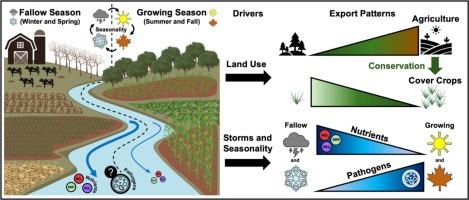季节性与混合土地利用和保护在控制农业流域养分和病原体输出模式方面相互作用
IF 2.5
3区 环境科学与生态学
Q3 ENVIRONMENTAL SCIENCES
引用次数: 0
摘要
肥料径流是农业流域排水的重要营养来源,并导致许多下游影响,包括富营养化和沿海缺氧。此外,与施用肥料有关的病原体出口对人类健康构成威胁,并导致娱乐场所关闭。农业保护措施,如种植冬季覆盖作物(CC),可以减少河流的养分损失,但它们对病原体运输的影响仍未得到充分研究。从2019年到2022年,我们在美国密歇根州的Paw河流域的三个子流域每2周采样一次,以评估CC在减少溶解硝酸盐(NO3——N)、铵(NH4+-N)、可溶性活性磷(SRP)和粪便大肠杆菌出口中的作用。这三个子流域的农业用地比例各不相同,从41%到77%不等。水柱NO3—N (mg L-1)在冬季和春季休闲季节达到峰值,大肠杆菌(CFU 100 mL−1)在夏季达到峰值,说明全年控制NO3—N和病原菌输出的驱动因素不同。溶解养分日产量的增加往往与农业土地覆被的增加相一致;然而,我们在农业土地覆盖最低的流域测量了最高的大肠杆菌日产量。种植CC可使NO3—N产量降低10 - 31%,NH4+-N产量降低19 - 22%,SRP产量降低3 - 11%,大肠杆菌产量降低17 - 48%,因此可有效减少农业景观中的养分和病原体输出,但需要进一步研究控制混合土地利用流域大肠杆菌输出的动态(时间和驱动因素)。本文章由计算机程序翻译,如有差异,请以英文原文为准。

Seasonality interacts with mixed land use and conservation in controlling patterns of nutrient and pathogen export from agricultural watersheds
Fertilizer runoff is a significant source of nutrients to streams draining agricultural watersheds and results in numerous downstream impacts including eutrophication and coastal hypoxia. Additionally, pathogen export linked to manure application poses a threat to human health and results in recreational closures. Agricultural conservation practices, such as the planting of winter cover crops (CC), can reduce nutrient losses to streams, but their impacts on pathogen transport remain understudied. From 2019 to 2022, we sampled every 2 weeks in three subwatersheds of the Paw Paw River Basin (Michigan, USA) to assess the role of CC in reducing dissolved nitrate (NO3–-N), ammonium (NH4+-N), soluble reactive phosphorus (SRP), and the fecal bacterium Escherichia coli export. The three subwatersheds contain varying levels of agricultural land use, ranging from 41 to 77 %. Water column NO3–-N (mg L-1) peaked during the winter and spring fallow season, while E. coli (CFU 100 mL−1) peaked during summer, which points to different drivers controlling NO3–-N and pathogen export throughout the year. Increased daily yields of dissolved nutrient tended to coincide with more agricultural land cover; however, we measured highest daily yields of E. coli in the watershed with lowest agricultural land cover. Planting CC reduced NO3–-N yield by 10–31 %, NH4+-N yield by 19–22 %, SRP yields by 3–11 %, and E. coli yields by 17–48 %, and therefore is effective at mitigating both nutrient and pathogen export from agricultural landscapes, but additional work is required to fully understand the dynamics (timing and drivers) controlling E. coli export in watersheds of mixed land use.
求助全文
通过发布文献求助,成功后即可免费获取论文全文。
去求助
来源期刊

Journal of Great Lakes Research
生物-海洋与淡水生物学
CiteScore
5.10
自引率
13.60%
发文量
178
审稿时长
6 months
期刊介绍:
Published six times per year, the Journal of Great Lakes Research is multidisciplinary in its coverage, publishing manuscripts on a wide range of theoretical and applied topics in the natural science fields of biology, chemistry, physics, geology, as well as social sciences of the large lakes of the world and their watersheds. Large lakes generally are considered as those lakes which have a mean surface area of >500 km2 (see Herdendorf, C.E. 1982. Large lakes of the world. J. Great Lakes Res. 8:379-412, for examples), although smaller lakes may be considered, especially if they are very deep. We also welcome contributions on saline lakes and research on estuarine waters where the results have application to large lakes.
 求助内容:
求助内容: 应助结果提醒方式:
应助结果提醒方式:


